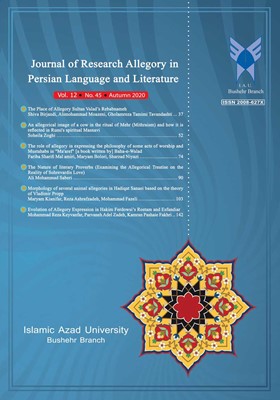Evolution of Allegory Expression in Hakim Ferdowsi’s Rostam and Esfandiar
Subject Areas : Research Allegory in Persian Language and Literaturemohammadreza kayvanfar 1 , Parvaneh Adel Zadeh 2 * , kamran pashaei 3
1 - Department of Literature, Azad University, Tabriz Branch, Tabriz, Iran
2 - Associate Professor, Department of Persian Language and Literature, Tabriz Branch, Islamic Azad University, Tabriz, Iran
3 - Associate Professor of Persian Language and Literature, Islamic Azad University, Tabriz Branch, Tabriz, Iran
Keywords:
Abstract :
At first glance, the story of Rostam and Esfandiar and considering the confrontation between them, it is expected throughout the story is of war, the clatter of swords, and the commotion of confrontation. The question is whether Ferdowsi's expression was technical, artistic, and mixed with allegorical, verbal or expressive images, or not? After a longitudinal study of the work from technical and verbal perspectives, the researcher has come to the conclusion that the story of Rostam and Esfandiar, which consists of long dialogues between two heroes, is a picture of novel expressive and aesthetic literature devices, especially in term of allegory in various forms, in a context of metaphorical applications of animism and foregrand, as well as, Simile, irony, permissibility, sensuality, vulgarity, epanodos (Laf-o-Nashr), and proverbs. It is more like a practice in expressing literary aesthetics than an epic content that can be simple and straightforward due to its very large content. The necessity of this research is to better understand the allegories used in the story of Rostam and Esfandiar for the students for using novel and expressive devices, in order to better understand the content of the Epic-letter )Razm-nameh(. The research has been conducted using library, descriptive and analytical methods on the Ferdowsi Hakim Shahnameh verses. And this is a sign of nurtured content, and deepening it through iterated revisions that Ferdowsi has incorporated for more than thirty years, from 369 to 402 Hijriijri.
مقالات
_||_

